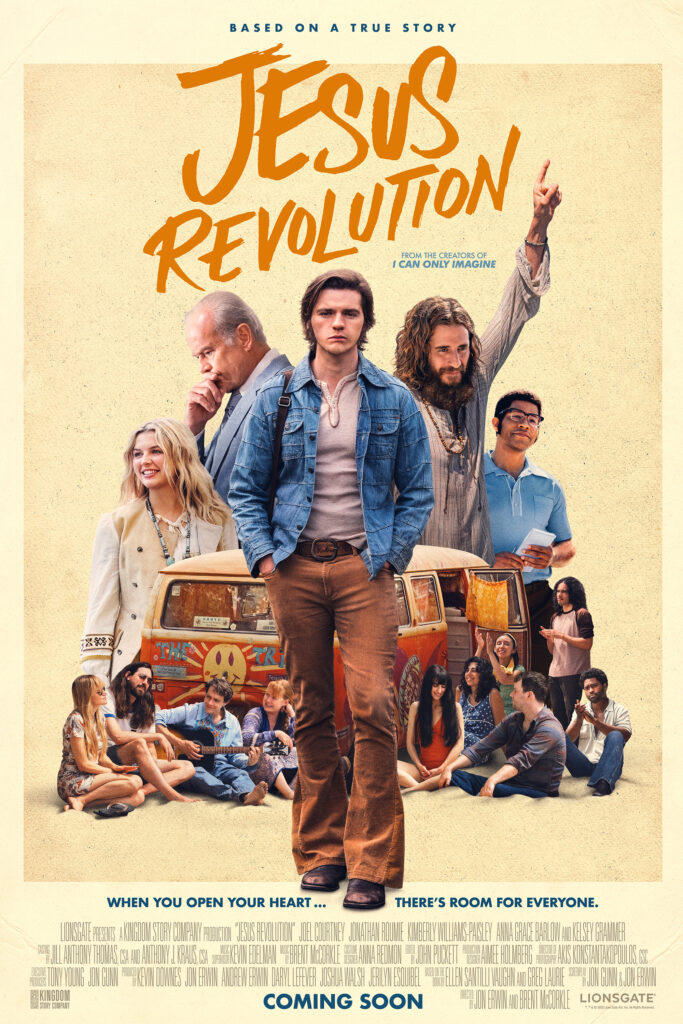From the studio that brought you such classic Christian films as “I Still Believe” and “I Can Only Imagine” comes a new biographical motion picture that is boldly, but accurately, titled “Jesus Revolution.” This film tells the true story of the humble beginnings of one of the greatest faith-based movements in the history of American Christianity. It takes us on a journey back to the late 1960’s, when hippies were on the move and generational divides were at an all-time high. We are taken to sunny Southern California where Pastor Charles “Chuck” Smith leads a small and dying congregation in the city of Costa Mesa, CA. Things take a dramatic turn for the better when, against his predetermined beliefs and reservations, Pastor Smith, played by seasoned actor Kelsey Grammer, meets with a young evangelical hippie by the name of Lonnie Frisbee, played by Jonathan Roumie of “The Chosen” fame. Through his profound wisdom and burning passion for spreading the gospel, Frisbee convinces Smith to open the doors of his church to the young and struggling hippie teens who are lost and are seeking a relationship with God. From its beginning, the film makes it instantly clear that this is going to be a deeply spiritual story of salvation and worship. The film opens to people being baptized in the Pacific Ocean and finding Christ for the first time. Then, we are introduced to a young teen named Greg Laurie, played by Joel Courtney. He is a young man struggling to find his way in life. From the beginning, two seemingly independent stories are being told interchangeably: a story of an old-fashioned pastor opening up to the young hippie teens, and a story of a young man looking for somewhere to start his life. This makes the film feel a bit unsure of itself as the two stories seem entirely unrelated for about the first hour of the film. However, each individual story on their own is well-structured and keeps the viewer entertained.
This film stands out amongst the many other Christian films of our modern age because it seems to understand how to tell its story specifically through the medium of film. This film executed many of its cinematic elements creatively and in a way that was stylistically pleasing. The costumes and scenic elements made it instantly obvious what time period we were in while not being overly exaggerated to the point that they seemed over- the-top. The actors brought nuanced and thrilling performances that elevated an otherwise dull and cliche script.
Finally, the editing of the various scenic shots was executed beautifully and kept a rhythm for most of the film that made it easy to keep the attention of its viewers. However, one major thing that this film suffers from that sadly is common amongst faith-based Christian cinema is that in many places, it sacrifices concise and smooth storytelling for the sake of driving home a message. Any good storyteller knows the main message of a story should be able to be supported and communicated in a naturally clear way through the plot devices. This film had an insanely large amount of source material to cover. Rather than editing and piecing together specific moments to tell a story that flowed at a natural pace throughout, the filmmakers seem to have tried to cram every detail of the true story into the just over two hours runtime. The focus seemed to be primarily on the significance of individual scene srather than on how each scene could work together to create a smooth and concise story arc. However, the messages that were preached throughout the film hit home in a deeply moving way. It beautifully illustrated the ways in which the world can criticize the Christian faith and how churches themselves can even more harshly criticize other believers. It also beautifully illustrates how believers from wildly different backgrounds and walks of life can be united as brothers and sisters in Christ to spread the good message It was also a great way to entertainingly teach viewers about an immensely significant moment in history for Christianity in the USA.
Overall, despite some questionable pacing and cheesy dialogue, “Jesus Revolution” is aware of its message and uses the art of film to its advantage to communicate that message.
